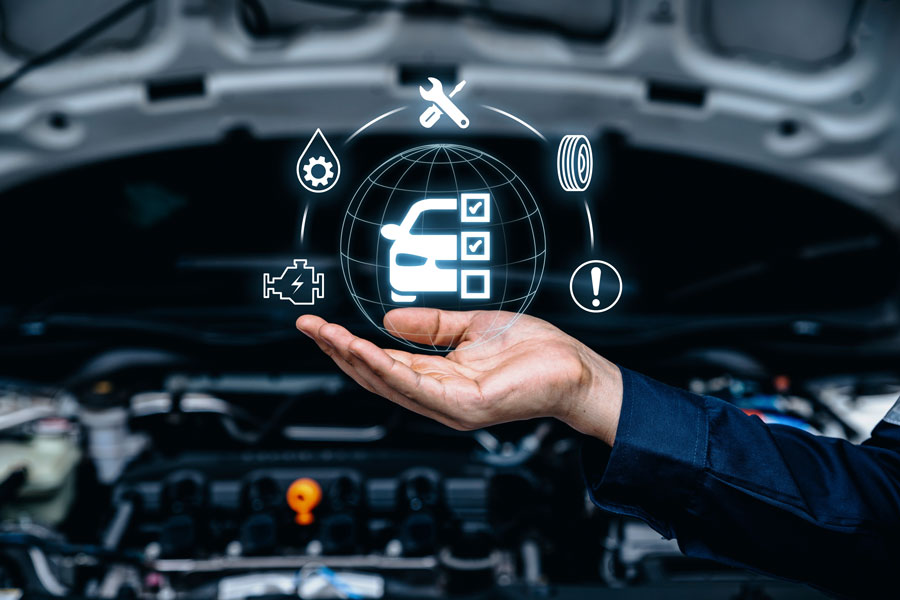For vehicles, failure to stick to service intervals or failure to carry out repairs can lead to a maintenance backlog. For drivers, maintenance backlogs can not only be expensive, but also dangerous. It is therefore crucial that both workshops and end customers recognise the importance of regular maintenance and repairs.
If the necessary maintenance and service work on a vehicle has been performed inadequately or not at all over a longer period of time, vehicle experts refer to this as a maintenance backlog. And the larger this backlog is, the more likely it is that faults, defects or signs of wear will build up quickly. Saving on regular work on the car means you're likely to pay for it later - and also involves significant risks.
Avoid maintenance backlogs - check the brake system!
The brake system is without doubt one of the almost important safety systems in a vehicle. Nevertheless, very few drivers know the current degree of wear of the brake system. Worn brake pads or discs can significantly impair braking performance. They should therefore be checked regularly and replaced if necessary. The brake fluid must also be replaced at regular intervals.
Worn or damaged tyres can increase the braking distance and increase the risk of aquaplaning. It is important to check the tyre pressure and tread depth regularly and replace the tyres if necessary. The tyres are not just the only interface between the vehicle and the road, the tyres can also indicate many problems and technical defects. Defects in the chassis setting, for example, can be identified very quickly by uneven wear on the tyre profiles. For this reason, it is also important to check the tyres regularly - or have them checked by the professionals in the workshop.
Identifying chassis damage early saves money!
The chassis, consisting of components such as shock absorbers, springs, axles and steering, plays a major role in ensuring that the vehicle remains stable even at high speeds, when cornering or during sudden reversing manoeuvres. A faulty or worn chassis can lead to reduced contact with the road, uneven tyre wear and reduced braking performance. A faulty chassis can also increase the risk of aquaplaning. Regular inspections can be used to detect and rectify signs of wear or defects at an early stage before they lead to serious safety problems or expensive consequential damage. And: A well-maintained chassis not only ensures safe driving, but also greater driving comfort and a longer vehicle service life.
Maintenance backlog on the engine? That can get really expensive!
The engine oil protects the engine against wear and ensures optimal performance. Regular oil changes extend the service life of the engine and avoid expensive repairs. A torn off oil film between the pistons and the cylinders can quickly lead to major engine damage. The oil level must therefore be checked regularly and the oil changed at the defined intervals.
The same applies to the timing belt. This should be replaced and checked regularly in accordance with the manufacturer's instructions. If it is porous, cracked or shows signs of wear on the teeth, it should be changed as quickly as possible.
Radiator fluid and antifreeze
Regular inspection of the coolant is crucial to ensure that an engine works properly. The coolant plays a key role in regulating the operating temperature. If the coolant level is too low, the engine may overheat, which can lead to severe damage. In winter, or more precisely at winter temperatures, the radiator fluid must have the required level of antifreeze.
Perfectly prepared for the TÜV inspection
The most common defects identified during the main inspection of vehicles vary depending on the region and age of the vehicle. But some typical defects have remained constant over the years. The most common issues include faulty, incorrectly set or dirty headlights, reversing lights, indicators and brake lights. The brakes are also a critical point: Worn brake pads, discs or uneven braking performance are often the reason for failing the vehicle inspection. Tyres are also a common problem. Worn tyre profiles, cracks, etc. can lead to significant safety risks. The chassis, particularly faulty shock absorbers, worn joints or damaged springs, is also often highlighted.
Not to forget rusting through or leaks in the exhaust system, which are also frequent defects identified. It is therefore advisable to check these points regularly in order to avoid a maintenance backlog and any nasty surprises during the TÜV inspection.
A maintenance backlog can be prevented by regular checks and by detecting signs of wear. Ensuring the safety and long life of the vehicle should always be the top priority.

